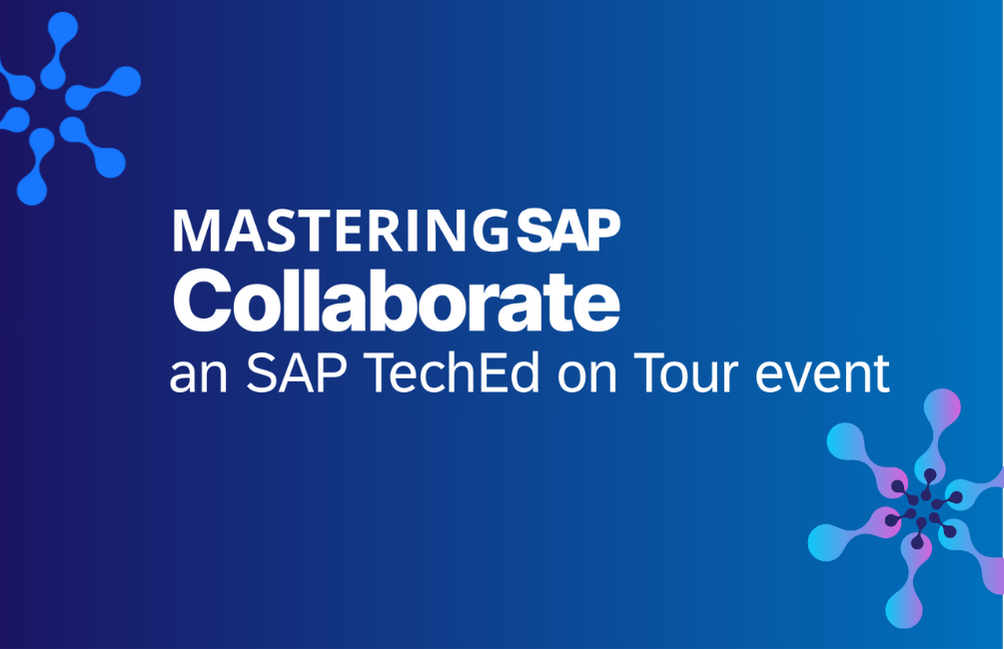SAP Accounting
Filter By
Browse By
- SAP Analytics and AI
- SAP Application Development and Integration
- All SAP Application Development and Integration
- SAP ABAP
- SAP ABAP Development Tools
- SAP ABAP Test Cockpit
- SAP API Management
- SAP BAPI
- SAP Basis
- SAP BRF
- SAP Business Application Studio
- SAP CMS
- SAP Design Studio
- SAP Development Tools
- SAP DevOps
- SAP EAI
- SAP EDI
- SAP Extension Suite
- SAP Fiori
- SAP Fiori Elements
- SAP Integration Suite
- SAP Low Code Application Development
- SAP Low Code Automation
- SAP Netweaver
- SAP Release Management
- SAP UI5
- SAP Web Application Server
- SAP Web IDE
- SAP Business Process Management
- SAP Center of Excellence
- SAP CIO
- SAP Customer Experience
- SAP Data and Data Management
- All SAP Data and Data Management
- SAP BW
- SAP BW/4HANA
- SAP Crystal Reporting
- SAP Data Archiving
- SAP Data Center
- SAP Data Governance
- SAP Data Integration
- SAP Data Migration
- SAP Data Quality
- SAP Data Services
- SAP Data Strategy
- SAP Data Visualization
- SAP Data Warehouse Cloud
- SAP DMS
- SAP Document Control
- SAP EIM
- SAP ETL
- SAP ETL Tools
- SAP HANA
- SAP HANA Administration
- SAP HANA Deployment Infrastructure
- SAP HANA Studio
- SAP Master Data
- SAP Master Data Governance
- SAP MDM
- SAP Enterprise Architect
- SAP Enterprise Asset Management
- SAP ERP
- SAP Finance
- All SAP Finance
- SAP Accounting
- SAP AR AP
- SAP Asset Accounting
- SAP Billing Systems
- SAP BPC
- SAP BRIM
- SAP Cash Management
- SAP Central Finance
- SAP Controlling
- SAP COPA
- SAP Cost Center Accounting
- SAP e-invoicing
- SAP FICO
- SAP Finance Automation
- SAP Financial Closing Cockpit
- SAP Financial Consolidation
- SAP Financial Planning
- SAP FX Risk
- SAP General Ledger
- SAP Global Tax Management
- SAP Hyperion
- SAP Order to Cash
- SAP Payment Processing
- SAP Profitability Analysis
- SAP Rebate Management
- SAP S/4HANA Finance
- SAP Universal Journal
- SAP Governance Risk and Compliance
- SAP Human Capital Management
- SAP Intelligent Technologies
- SAP Platform and Technology
- All SAP Platform and Technology
- SAP Business Technology Platform
- SAP Cloud Connector
- SAP Cloud Integration Platform
- SAP Cloud Migration
- SAP Cloud Platform
- SAP Cloud Providers
- SAP Cloud Strategy
- SAP Container Platform
- SAP Digital Asset Management
- SAP Digital Integration Hub
- SAP Digital Signature
- SAP HANA Enterprise Cloud
- SAP HEC
- SAP Hyperscalers
- SAP Infrastructure
- SAP Messaging
- SAP Smart Forms
- SAP Quality and Testing
- SAP Security
- SAP Spend Management
- SAP Supply Chain Management
- All SAP Supply Chain Management
- SAP APO
- SAP Asset Management
- SAP Business Network
- SAP Digital Manufacturing Cloud
- SAP Digital Twin
- SAP EWM
- SAP IBP
- SAP Inventory Management
- SAP Label Printing
- SAP Logistics
- SAP Manufacturing
- SAP Manufacturing Automation
- SAP MES
- SAP MII
- SAP MM
- SAP MRO
- SAP MRP
- SAP Order Management
- SAP Plant Maintenance
- SAP PLM
- SAP Production Planning
- SAP S&OP
- SAP SD
- SAP SPM
- SAP Supply Chain Planning
- SAP Track and Trace
- SAP Transportation Management
- SAP System Administration
SAP Accounting: An overview and key considerations
What Is SAP Accounting?
SAP Accounting consists of two core modules that represent separate accounting books. SAP customers utilize SAP Financial Accounting (FI) for external reporting with financial statements and SAP Controlling (CO) for internal reporting purposes.
SAP Accounting enables organizations to deliver financial performance information necessary for effective decision-making by consolidating data from functional modules with powerful reporting tools. It is critical to ensure all aspects of an organization’s financials are integrated in a way that makes it easier for finance and accounting managers to access the information they need when they need it. SAP accounting modules are designed to make managing and reporting accounting data easier across organizations, teams, and roles, to support the generation of income statements, balance sheets, and cash flow statements.
For many organizations, SAP Accounting manages transactions across these core financial functions:
- Accounts payable/accounts receivable
- Bank accounting
- Cash journal
- Financial close
- Financial statements
- Fixed asset accounting
- General ledger
- Inventory
- Master data governance
- Multiple charts of accounts and parallel valuations
- Tax accounting.
Key Considerations for SAPinsiders
SAP Accounting: An overview and key considerations
What Is SAP Accounting?
SAP Accounting consists of two core modules that represent separate accounting books. SAP customers utilize SAP Financial Accounting (FI) for external reporting with financial statements and SAP Controlling (CO) for internal reporting purposes.
SAP Accounting enables organizations to deliver financial performance information necessary for effective decision-making by consolidating data from functional modules with powerful reporting tools. It is critical to ensure all aspects of an organization’s financials are integrated in a way that makes it easier for finance and accounting managers to access the information they need when they need it. SAP accounting modules are designed to make managing and reporting accounting data easier across organizations, teams, and roles, to support the generation of income statements, balance sheets, and cash flow statements.
For many organizations, SAP Accounting manages transactions across these core financial functions:
- Accounts payable/accounts receivable
- Bank accounting
- Cash journal
- Financial close
- Financial statements
- Fixed asset accounting
- General ledger
- Inventory
- Master data governance
- Multiple charts of accounts and parallel valuations
- Tax accounting.
Key Considerations for SAPinsiders
Prioritize industry-specific and business process-related compliance needs across accounting and finance requirements. SAP Accounting is an essential component of SAP ERP that provides organizations with global processes and information to account for the new standards of accounting, while maintaining flexibility to incorporate regulatory updates. SAP Accounting solutions can help organizations effectively meet global accounting and financial reporting standards to enforce compliance.
Consider opportunities to modernize accounting workstreams and provide operational visibility across virtual teams.The transition to a fully remote working environment has caused difficulties for accounting professionals, particularly as it relates to their dependence on spreadsheets, inability to access data, limited process documentation, and daily manually intensive tasks. Organizations can automate their workflows with SAP Accounting tools, freeing them to do more optimization and customization.
Leverage SAP Accounting products to enable accounting teams to do more with less. COVID-19 variants, virtual work, supply chain disruptions, inflation concerns, and the Great Resignation, represent some of the major challenges creating uncertainty for organizations across the current operating environment. With the uncertainty of this economy, accounting is required to give more up-to-date information to make smarter decisions in real time.
976 results
-

Effectively Manage Post-Dated Checks with Portfolios
Published: 22/July/2010
Reading time: 12 mins
See how to configure post-dated checks in your standard Bank Accounting submodule in FI. Follow the various process steps in a sample business scenario in Thailand. Key Concept A portfolio is a collection or group of checks. The SAP system contains various transactions for the different processes associated with the life cycle of checks from...…
-

Automate Travel Expense Settlement and Transfer to Finance
Published: 08/February/2012
Reading time: 12 mins
Learn how to automate the process of settlement and transfer to finance of trip reports created in the SAP Travel Management module. Then, once the trip report is approved, it is automatically settled and posted into FI. Understand the settings, as well as the tips and tricks, needed to set up this automation batch job....…
-

Tackle Changes to Inventory, Cash Flow, and Benefit Regulations with SAP ERP
Published: 30/December/2009
Reading time: 14 mins
Review some accounting standard changes, including changes to foreign exchange rates, inventory, and benefits, and see how the SAP ERP system can address them. Key Concept The driver of International Financial Reporting Standards (IFRS) and International Accounting Standards (IAS) is the need to bring uniformity and consistency to accounting practices and reporting across the globe....…
-
-

IFRS Adoption for US Companies: A Primer
Published: 17/April/2009
Reading time: 8 mins
/GRCWorried about the impending US conversion to International Financial Reporting Standards (IFRS)? See some quick hints about things you should know and places you can look for information as the landscape changes. Key Concept International Financial Reporting Standards (IFRS) is a reporting standard that is being adopted worldwide, and likely impending for the United States...…
-

Handle Partially Reclaimable VAT with Pro-Rata VAT Functionality in Your SAP System
Published: 27/October/2009
Reading time: 27 mins
Many organizations in the EU use Value Added Tax (VAT) on certain sales. However, not all sales allow VAT charges. If you’re a company providing products that are both VAT-eligible and VAT-ineligible, how do you account for this in your system? See how to set up and customize pro-rata VAT in your SAP system. Key...…
-

A Simplified Approach for Consolidation of Investments
Published: 02/March/2012
Reading time: 21 mins
Learn how to automate consolidation of investments as you use Enterprise Controlling-Consolidation (EC-CS) and Strategic Enterprise Management-Business Consolidation System (SEM-BCS) functionality to expedite your period-end close. See how you can achieve this without a full-blown implementation of the consolidation of investments component. Key Concept The consolidation of investments (COI) component comes delivered with Strategic Enterprise...…
-

Maintain Data Integrity by Implementing Profit Center Planning in the New General Ledger
Published: 15/April/2008
Reading time: 8 mins
Find out how to implement profit center planning in the new General Ledger and how to transfer planning data from Cost Center Accounting and Profitability Analysis to profit centers. Key Concept For SAP ERP 5.0 and 6.0, SAP integrated Profit Center Accounting into the new General Ledger (new G/L), so the profit center planning functionality...…
-
-

Reduce Your Company’s Spending with Automatic Clearing of Vendor Down Payments
Published: 25/November/2013
Reading time: 12 mins
See how to use the down payment process with the automatic clearing option with the materials management (MM) and Financial Accounting (FI) modules in SAP ERP Central Component (SAP ECC) 6.0. These solutions have already been implemented in production environments for MM and FI in SAP ECC 6.0. However, the processes also apply to previous...…
-

Drive Finance Automation with Continuous Innovation Culture
Published: 29/September/2021
Reading time: 6 mins
By Ogo Nwanyanwu, Research Director, SAPinsider Digital transformation often starts with financial automation. Finance and accounting teams that embrace a “culture of continuous innovation,” are well-positioned to drive process optimization in support of financial automation adoption. Key Takeaways: Organizations are adopting financial automation to manage increased complexities and demand facing today’s finance function End-to-end financial process automation adoption is now a critical component of engaging a finance/accounting workforce…
-

Troubleshoot the Three SAPSprint Root Error Categories for Server-Based Printing on Windows
Published: 29/October/2009
Reading time: 17 mins
A failed printout can delay or disrupt important meetings or cause you to miss deadlines. See how to avoid printer failures when using SAPSprint by analyzing the three most common types of errors. Also find answers to common SAPSprint issues in the SAPSprint FAQs. Key Concept Processing in SAPSprint involves generating print data via the...…
Become a Member
Unlimited access to thousands of resources for SAP-specific expertise that can only be found here.
Upcoming Events
-

Mastering SAP Collaborate an SAP TechEd on Tour event
November 12 - 14, 2025
Sydney, New South Wales
Australia
View Event
Related Vendors
Your request has been successfully sent

